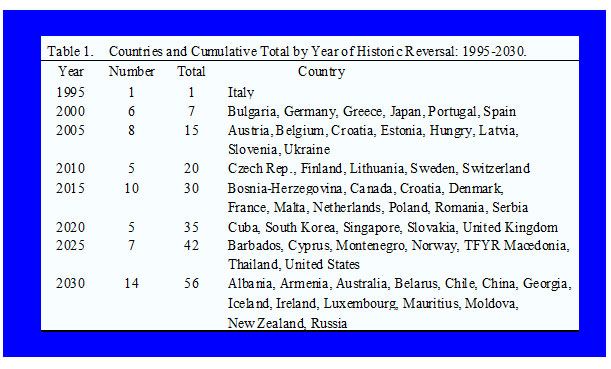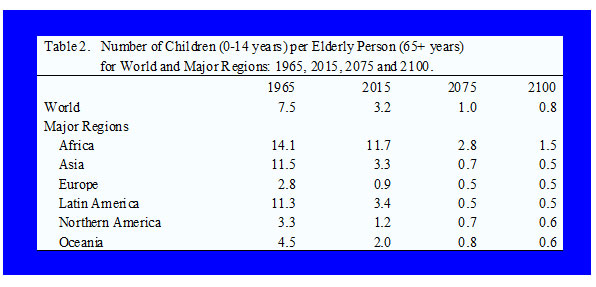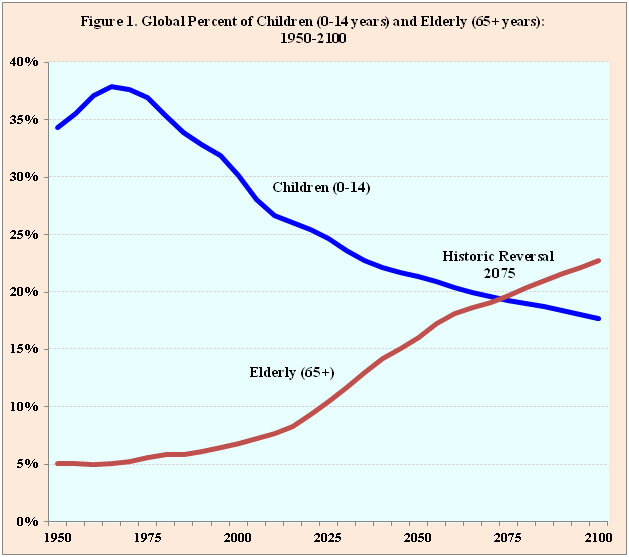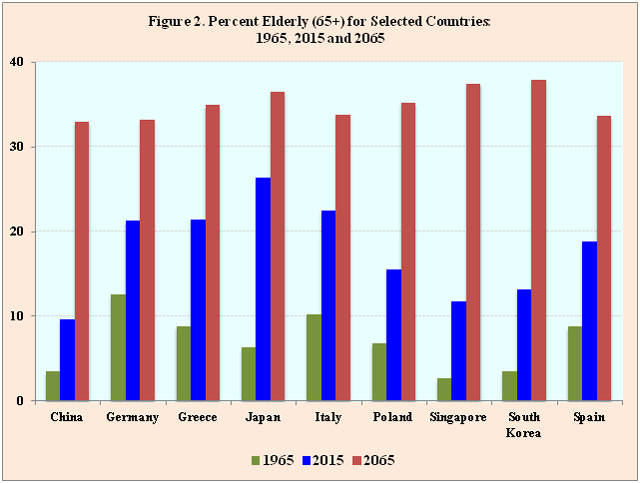The Historic Reversal of Populations
IN FOCUS, 15 Aug 2016
Joseph Chamie – Inter Press Service-IPS
8 Aug 2016 – It first happened in Italy in 1995. Five years later, it happened in six additional countries, Bulgaria, Germany, Greece, Japan, Portugal and Spain. Today the total number of countries where it has occurred stands at 30, including most members of the European Union. In fifteen years that number is expected to nearly double and include Australia, Canada, China, Russia, South Korea and the United States (Table 1).
What happened to those countries – and will continue to occur to virtually every country’s population worldwide – is the Historic Reversal or the demographic turning point when children in a population become fewer than its elderly. This noteworthy milestone reflects the significant and far-reaching aging transformation of human populations taking place largely during the 21st century.
Throughout human history children were substantially more numerous than the elderly. Even a half century ago, the world’s population of 3.3 billion had on average more than seven children under 15 years of age for each elderly person aged 65 and over. Africa’s population in 1965 topped other major regions with more than 14 children per elderly person, followed by Asia and Latin America with more than 11 children per elderly person and Europe and Northern America at around 3 children per elderly person (Table 2).
Today the global ratio for the world’s 7.4 billion people has been halved to about three children per elderly person. While Africa’s population continues to have the highest ratio with nearly 12 children per elderly person, the ratios for Asia and Latin America are close to the current world average. In contrast, the population of Europe, which just recently experienced the Historical Reversal, has slightly less than one child per elderly person.
By 2075 the world’s projected population of 10.7 billion is expected to pass through the Historical Reversal with elderly persons becoming increasingly more numerous than children (Figure 1). The only major region that will not experience the Historical Reversal during the 21st century is Africa, which is projected to have 1.5 children per elderly person in 2100 with some countries, such as Niger, Nigeria and Somalia, having more than twice as many children as elderly. At that time, all the other major regions of the world are expected to have about twice as many elderly persons as children.
The two key factors bringing about the Historic Reversal of population age structures are declining fertility rates and rising life expectancies. In every corner of the world, women are bearing fewer children than in the past. Whereas the average global fertility rate in 1965 was five births per woman, today it has fallen to half that level, with 75 countries or close to half the world’s population experiencing rates below the replacement level of about two births per woman.
In addition to rising life expectancies at birth, people are living longer than ever before as mortality rates among the elderly are declining. Over the past five decades the world’s life expectancy at age 65 has increased by nearly five years, with some countries, such as China, Japan, Singapore and South Korea, making gains of seven or more years. As a consequence, since 1950 the proportion aged 80 and older among the world’s elderly increased from one in ten to one in five. In addition, since the start of the 21st century, the number of centenarians, those aged 100 years or older, has tripled compared to a 20 percent increase in world population.
Moreover, while world population is projected to increase by 40 percent by 2065, the number of elderly aged 65 years or older is expected to more than triple. By that year, some countries, such as China, Germany, Greece, Japan, Italy, Poland, Singapore, South Korea and Spain, are expected to have elderly persons account for one-third or more of their population (Figure 2).
Among the world’s children aged 0 to 14 years, boys are a slight majority at 52 percent. However, due to the higher mortality rates of males, women make up majority among the elderly. Women represent 55 percent of persons aged 65 and older and more than 60 percent of the elderly above 80 years old.
While population age structures worldwide are becoming older, developing countries are going through the aging process at a substantially faster pace than took place in developed countries. For example, France took more than a century and the United States close to three-quarters of a century for their elderly populations aged 65 and over to increase from 7 to 14 percent. In contrast, developing countries, such as Brazil, China, Indonesia, Iran and Thailand, are making that aging transformation in a quarter century or less.
The Historic Reversal and population aging certainly constitute a noteworthy demographic achievement. However, this achievement also comes with significant economic, social and political consequences needing societal attention, policy changes and program adjustments. Although gradual, the effects of population aging on a nation are pervasive and considerable, impacting all major spheres of human activity, including consumption, employment, voting, defense, foreign policy, recreation, health care, entertainment, family, immigration and taxation.
In particular, population aging presents a major challenge to government old age pension systems with more elderly beneficiaries and relatively fewer workers contributing to support them. To sustain pension programs for the elderly, countries have a number of options at their disposal.
Governments may choose to increase taxes, redirect government revenue, reduce benefits or privatize old age pension schemes. Understandably, those options are not met with enthusiasm by the general public, especially the elderly.
Other options include raising below replacement fertility levels and increasing the immigration of workers. However, even if fertility rates were to rise, which seem unlikely in the near term, it would take a couple of decades before the additional children could join the work force.
Adding immigrant workers, in contrast, would immediately expand the labor force. But eventually those workers also age, join the elderly population and rely on government pension programs. Over time this would in turn require even more immigrant workers to support the growing numbers of elderly persons.
Perhaps the least objectionable option to sustain pension programs is to raise the official retirement age. Increases in retirement ages are typically gradual and take effect in the distant future. Nevertheless, proposed increases in the statutory age of retirement, especially when linked to rising life expectancies, are frequently met with protests and demonstrations.
Insofar as none of the options to sustain old age pension programs are popular among voters and most elected officials, the needed policy changes are often postponed coupled with nebulous pledges to “save” old age pension systems. While this may be politically expedient and temporarily calm public anxiety, postponements make needed changes and adjustments even more pressing, difficult and costly in the future.
As a result of low birth rates, improved chances of survival and longer life, the Historic Reversal appears certain to happen in most countries during the 21st century. What remains uncertain, and appears somewhat worrisome at this point in time, is whether governments and the general public will respond effectively, responsibly and in a timely manner to the Historic Reversal and the many challenges being brought about by population ageing.
____________________________________
Joseph Chamie is an independent consulting demographer and a former director of the United Nations Population Division.
DISCLAIMER: The statements, views and opinions expressed in pieces republished here are solely those of the authors and do not necessarily represent those of TMS. In accordance with title 17 U.S.C. section 107, this material is distributed without profit to those who have expressed a prior interest in receiving the included information for research and educational purposes. TMS has no affiliation whatsoever with the originator of this article nor is TMS endorsed or sponsored by the originator. “GO TO ORIGINAL” links are provided as a convenience to our readers and allow for verification of authenticity. However, as originating pages are often updated by their originating host sites, the versions posted may not match the versions our readers view when clicking the “GO TO ORIGINAL” links. This site contains copyrighted material the use of which has not always been specifically authorized by the copyright owner. We are making such material available in our efforts to advance understanding of environmental, political, human rights, economic, democracy, scientific, and social justice issues, etc. We believe this constitutes a ‘fair use’ of any such copyrighted material as provided for in section 107 of the US Copyright Law. In accordance with Title 17 U.S.C. Section 107, the material on this site is distributed without profit to those who have expressed a prior interest in receiving the included information for research and educational purposes. For more information go to: http://www.law.cornell.edu/uscode/17/107.shtml. If you wish to use copyrighted material from this site for purposes of your own that go beyond ‘fair use’, you must obtain permission from the copyright owner.




